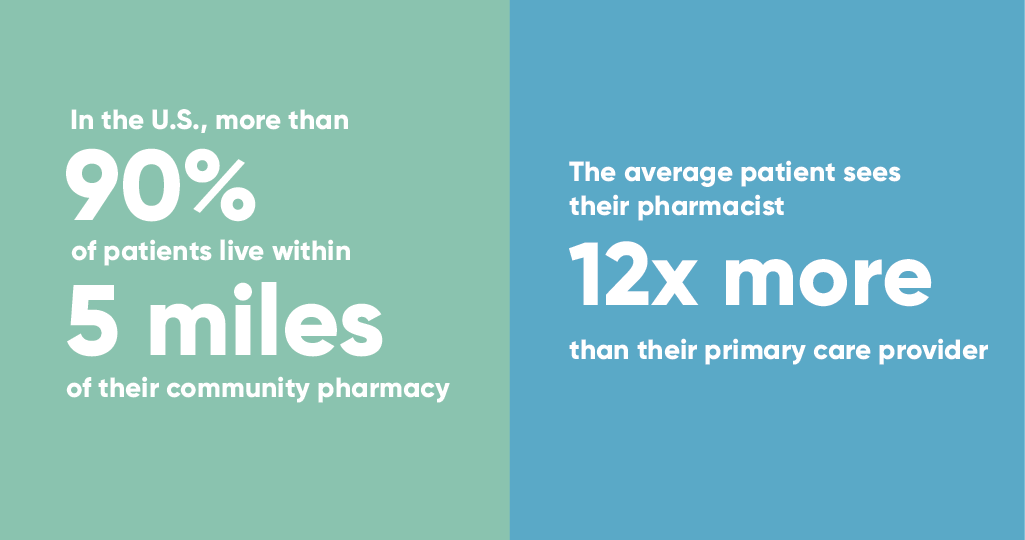Pharmacists as Partners in Personalized Patient Care
By Farah Madhat, PharmD, MA
What does it mean to be a provider in today’s healthcare landscape? Accelerated by the introduction of new technologies, the role of community pharmacists has grown substantially over the last 10 years. The corner pharmacy has evolved from a place to refill medications – and maybe stock up on a few additional household needs – to a resource for clinical services and delivery of convenient primary care offerings like medication risk assessments, vaccinations, blood pressure assessments, and even Medicare plan reviews.
In the U.S., more than 90% of patients live within 5 miles of their community pharmacy, and the average patient sees their pharmacist 12 times more often than their primary care provider. That’s why these pharmacies are in a unique position to take on an increased role in primary and preventive care, subsequently freeing up traditional primary care providers to focus on more complex patient needs. For example, during the COVID-19 pandemic, community pharmacies began offering Clinical Laboratory Improvement Amendments (CLIA)-waived point-of-care tests, as well as vaccinations.1

Simply put, the scope of practice has changed for pharmacists, who now provide consultations, referrals, and point-of-care testing (POCT). In some states, pharmacists have also taken on roles in furnishing hormonal contraceptives, antibiotics, antivirals, initiating preventative therapy, and adjusting current therapies. As such, community pharmacists are further looking to partner with patients and prescribers to offer and enhance personalized care via collaborative practice agreements. In many cases, this means embracing innovation.
Tech Meets Service
In today’s climate, technological advancement is key to innovation. This is especially true regarding the evolution of the healthcare industry. Community pharmacists don’t just need to keep up with new technologies; they must become leaders in a changing healthcare setting to benefit patients and practices. The advent of new digital technologies has already led to faster, smarter automated processes as community pharmacies tailor practices to serve local communities. For example, patient communication via text and telephone reminders helps to improve patient adherence and inform them of critical healthcare milestones.
The COVID-19 crisis has demonstrated how technological developments and interoperability have led to more fluid, transparent, and accessible systems and processes to meet patients’ and health professionals’ expectations. The use of digital platforms, such as electronic health records, telehealth and artificial intelligence, as well as mobile health, wearables, and remote monitoring sensors, has led to improved patient access and continuity of care. This would not have been possible without the COVID-19 lockdown and travel restrictions.
Digital technologies will continue to drive healthcare innovation. User-friendly intuitive tools now enable community pharmacists to develop a broader understanding of the whole patient to prevent adverse drug events (ADEs) and improve outcomes for both the patient and pharmacy. Powered by proprietary MedWise® Science, a MedWise Safety ReviewTM helps pharmacists improve MTM by assigning a MedWise Risk ScoreTM based on a patient’s current prescriptions, over-the-counter (OTC) medications, and supplements. These platforms allow community pharmacies to monitor for multi-drug interactions and adjust medication regimens proactively.
Despite continuous technological innovation, community pharmacies still face plenty of challenges. For example, direct and indirect remuneration (DIR) fees on prescriptions under Medicare represent a two-fold financial burden, increasing the cost of patient medication and squeezing pharmacy margins based on inconsistent quality standards. According to the CDC, DIR fees increased by a staggering 91,000% between 2010 and 2017.2 The push for legislative change regarding DIR fees is in progress federally, with current legislation largely determined at the state level. New technologies and workflows present an opportunity to expand revenue without additional staff...
Continue reading the blog here.